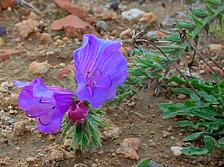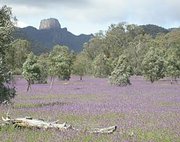Patterson's Curse
|
|
- For the indie rock band, see Patterson's Curse.
| Patterson's Curse | ||||||||||
|---|---|---|---|---|---|---|---|---|---|---|
 | ||||||||||
| Scientific classification | ||||||||||
|
Patterson's Curse or Paterson's Curse (Echium plantagineum) is an invasive annual plant native to the area surrounding the Mediterranean Sea, but best known in Australia, where it is also known as Salvation Jane (particularly in South Australia). Other names are Blueweed, Lady Campbell Weed or Riverina Bluebell.
In the 1880s it was introduced to Australia, probably both as an accidental contaminate of pasture seed and as an ornamental plant. It is said that the name derives from the bitter experience of the Paterson or Patterson family, early settlers of the country near Albury. They had the first seeds brought from Europe to beautify their garden, and then could only watch helplessly as the weed infested previously productive pastures for many miles around.
Patterson's Curse is now a dominant pasture weed through much of New South Wales, the Australian Capital Territory, Victoria, South Australia and Tasmania and also infests native grasslands, heathlands and woodlands. The plants contain alkaloids and, when eaten in large quantities, cause reduced livestock weight or even (in severe cases) death.
Patterson's Curse has positive uses — it is the source for a particularly fine grade of honey (although some say that Patterson's Curse honey may be poisonous, especially after drought [1] (http://www.abc.net.au/rn/talks/8.30/helthrpt/stories/s1037977.htm)) and, with proper handling, is used for cattle (though not sheep) feed in northern South Australia. However, the annual cost in control measures and lost production was estimated (in a 1985 study by the Industries Assistance Commission) to be over $30 million, compared to $2 million per year in benefits.
The plant has hairy, dark green, broadly oval rosette leaves to 30cm long. The several seeding stems grow to 120cm in height and develop branches with age. Flowers develop in clusters; they are purple, tubular and 2-3 cm long with 5 petals. It has a fleshy taproot with smaller laterals.
Although generally a spring-flowering annual, Patterson's Curse is highly adaptable and, given suitable rainfall, some plants germinate out-of-season and endure for longer than one year. It is a very prolific seed producer; heavy infestations can yield up to 30,000 seeds per square metre. Patterson's Curse can germinate under a wide variety of temperature conditions, tolerates dry periods well and responds vigorously to fertiliser. If cut by a lawnmower, it quickly recovers and sends out new shoots and flowers.
The plant disperses by movement of seeds — on the wool or fur of animals, the alimentary tracts of grazing animals or birds, movement in water and most importantly as a contaminant of hay or grain. This is most noticeable in times of drought, when there is considerable movement of fodder and livestock.
It can rapidly establish a large population on disturbed ground and competes vigorously with both smaller plants and the seedlings of regenerating overstorey species. Its spread has been greatly aided by human-induced habitat degradation, particularly the removal of perennial grasses through overgrazing by sheep and cattle and the introduction of the rabbit. Patterson's Curse is rarely able to establish itself in habitats where the native vegetation is healthy and undisturbed.

Control of the plant is carried out by hand (for small infestations) or with any of a variety of herbicides, and must be continued over many years to reduce the seedbank. (Most seeds germinate in the first year, but some survive for as long as five years before germinating.) In the longer term, perennial grasses (which do not need to regenerate from seed each year) can out-compete Patterson's Curse, and any increase in perennial cover produces a direct decrease in Patterson's Curse.
The CSIRO has investigated numerous biological control measures, and of the 100-odd insects found feeding on Patterson's Curse in the Mediterranean, judged six safe to release in Australia without endangering crops or native plants. The weevils Mogulones larvatus and Mogulones geographicus and the flea beetle Longitarsus echii are currently in use by the New South Wales Department of Agriculture. While the CSIRO is modestly optimistic, it is expected that biological control measures, if they are successful at all, will take decades to be effective.
Three other Echium species have been introduced and are of concern; Viper's Bugloss (Echium vulgare) is the most common of them. Viper's Bugloss is biennial, with a single unbranched flowering stem and smaller, more blue flowers, but is otherwise similar. This species is also useful for honey production.es:Echium plantagineum
